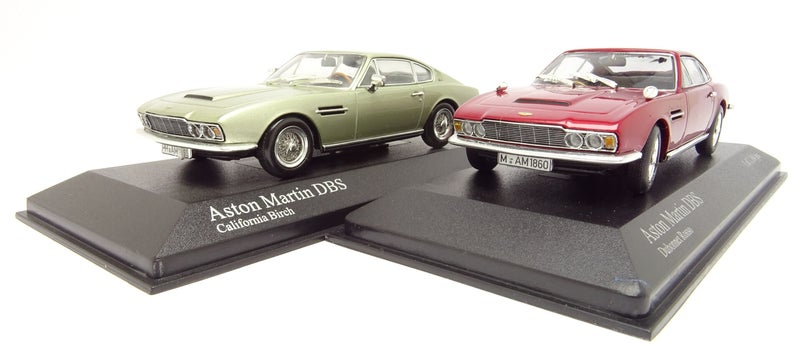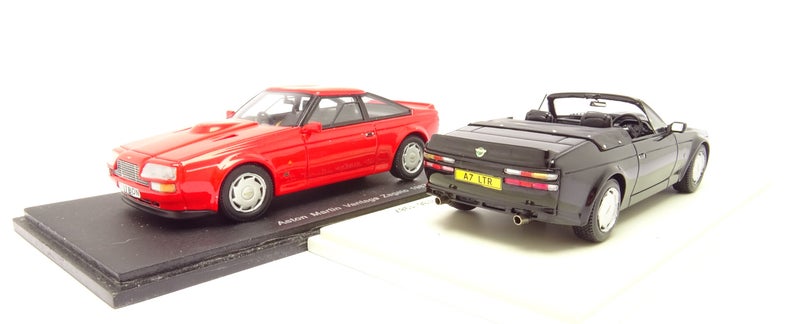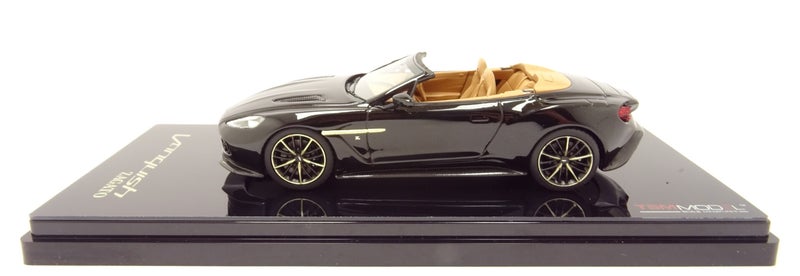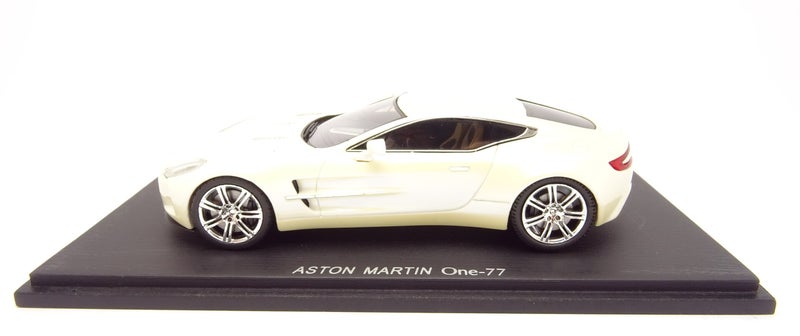

Aston Martin – from the "Aston Hill" races (near Aston Clinton) where the company was founded, and the surname of Lionel Martin, the company's founder.
Aston MartinLagonda Global Holdings plc is a British independent manufacturer o f luxury sports cars and grand tourers. It was founded in 1913 by Lionel Martin and Robert Bamford. Steered from 1947 by David Brown, it became associated with expensive grand touring cars in the 1950s and 1960s, and with the fictional character James Bond following his use of a DB5 model in the 1964 film Goldfinger. Their grand tourers and sports cars are regarded as a British cultural icon.


Headquarters: Gaydon, Warwickshire, United Kingdom, 1913-1947

Headquartered: David Brown Ltd., Huddersfield, UK, 1947-1972

Headquartered: Company Developments, Birmingham, UK, 1972-1975

Headquartered: Aston Martin Lagonda Limited, Gaydon, Warwickshire, UK, 1975-1981

Headquartered: Victor Gauntlett/ Pace Petroleum, Al Kuwait, Kuwait,1981-1987

Headquartered: Ford Motor Company, Dearborn, Michigan, 1987-2007

Headquartered: Private Limited Company, 2007-2018

Parent: Public Investment Fund, Riyadh, Saudi Arabia, 2018-now





db5

The Aston Martin DB5 is a British grand tourer (GT) produced by Aston Martin and designed by Italian coachbuilder Carrozzeria Touring Superleggera. Originally produced from 1963 to 1965, the DB5 was an evolution of the final series of DB4. The "DB" designation is from the initials of David Brown who built up the company from 1947 onwards.


dbs

The Aston Martin DBS is a grand tourer produced by the British manufacturer Aston Martin Lagonda Limited from 1967 to 1972. From 2007 to 2012 the DBS name was resurrected for a new model, also called the Aston Martin DBS.
The DBS was intended as the successor to the Aston Martin DB6, although the two ran concurrently for three years. Powered by a straight-six engine, it was produced from 1967 until 1972, eventually being phased out in favour of the Aston Martin V8.


set of DBS Aston Martin DBS Set








v8

The Aston Martin V8 is a grand tourer manufactured by Aston Martin in the United Kingdom from 1969 to 1989. As with all traditional Aston Martins, it was entirely handbuilt – with each car requiring 1200 man-hours to finish.
Aston Martin were looking to replace the DB6 model and had designed a larger, more modern looking car. The engine was not ready, however, so in 1967 the company released the DBS with the straight-six Vantage engine from the DB6. Two years later, Tadek Marek's V8 was ready, and Aston released the DBS V8. With the demise of the straight-six Vantage in 1973, the DBS V8, now restyled and called simply the Aston Martin V8, became the company's mainstream car for nearly two decades. It was eventually retired in favour of the Virage in 1989.

set of v8 vantage and volante https://www.youtube.com/watch?v=nVOu0mKvCts&ab_channel=thebiggarage











set of v8 vantage and volante https://www.youtube.com/watch?v=vXs4cvaoNAQ
zagato
The model V8 Zagato by Aston Martin was a grand tourer of the 1980s. It was baesd on the V8. Just fifty two examples of the coupé and thirty seven of the convertible were built between 1986 and 1990. The coupé was first unveiled at the 1986 Geneva Motor Show, and orders were quickly taken despite only showing the drawing of the car.





lagonda

The Aston Martin Lagonda is a full-size luxury four-door saloon manufactured between 1974 and 1990. A total of 645 were produced. The name was derived from the Lagonda marque that Aston Martin had purchased in 1947. There are two distinct generations, the original, the short lived 1974 design based on a lengthened Aston Martin V8, and the entirely redesigned, wedge-shaped Series 2 model introduced in 1976. The Lagonda was the first production car to use a digital instrument panel. Engine and power output: 5.3-L DOHC V8, 280 hp and top speed of 240km/h.

set of zagato vantage and volante https://www.youtube.com/watch?v=x6W_YJtzp2Y



virage

The Aston Martin Virage is an automobile produced by British luxury automobile manufacturer Aston Martin as a replacement for its V8 models. Introduced at the Birmingham Motor Show in 1988, it was joined by the high-performance Vantage in 1993, and then the name of the base model was changed to V8 Coupé in 1996.

set of virage and virage volante https://www.youtube.com/watch?v=fI52TpH339A&ab_channel=thebiggarage











db7

The Aston Martin DB7 is a car that was produced by British luxury car manufacturer Aston Martin from September 1994 to December 2004. It was designed by Ian Callum and Keith Helfet as a grand tourer in coupé and convertible bodystyles. The prototype was complete by November 1992 and debuted at the Geneva Motor Show in March 1993. The six-cylinder DB7 (based on the Jaguar AJ6 engine) was positioned as an "entry-level" model below the hand-built V8 Virage introduced a few years earlier. This model was the most-produced Aston Martin automobile up to that point in time, with more than 7,000 built before it was replaced by the DB9 in 2004.






vanquish

The Aston Martin Vanquish is a grand tourer introduced by British luxury automobile manufacturer Aston Martin in 2001 as a successor to the Aston Martin Virage (1993). The Aston Martin V12 Vanquish, designed by Ian Callum was produced from 2001 to 2007 as the flagship of the marque.
The second-generation "Vanquish" was introduced in 2012, this time based on Aston Martin's existing VH platform – similar to the one that underpinned the DB9.






db9

The Aston Martin DB9 is a two-door grand touring car. It was produced in Gaydon, Warwickshire, by the British carmaker Aston Martin between 2004 and 2016 as both a coupé and a convertible, the latter known as the "Volante".
Succeeding the DB7, which Aston Martin produced from 1994 until 2004, the DB9 was designed by Ian Callum and Henrik Fisker and debuted at the Frankfurt Motor Show in 2003, while the Volante debuted at the Detroit Auto Show in the subsequent year.



set of db9 coupe and convertible https://www.youtube.com/watch?v=Sul9ZwNtUE0









vantage

The Aston Martin Vantage is a series of hand-built sports cars from the British automotive manufacturer Aston Martin. Aston Martin has previously used the "Vantage" name on high-performance variants of their existing GT models, notably on the Virage-based car of the 1990s. The modern car, in contrast, is the leanest and most agile car in Aston's lineup. As such, it is intended as a more focused model to reach out to potential buyers of cars such as the Porsche 911 as well as the exotic sports and GT cars with which Aston Martins traditionally compete.



set of v8 vantage coupe & roadster Aston Martin V8 Vantage Coupe & Roadster (youtube.com)

















rapide

The Aston Martin Rapide is an executive saloon car that was produced by the British carmaker Aston Martin from 2010 until 2020.
Aston Martin, responding to declining demand for luxury saloons and aligning production with reduced sales, reduced annual output from 2000 to 1250 in June 2011. In 2012, Aston Martin relocated production of the Rapide to Gaydon until it was discontinued in 2020.
Aston Martin debuted an electric concept version, the Rapide E. The production-ready model debuted in 2019 but was never series-produced.




































1913-1926
1927-1930
1930-1932
1932-1939
1939-1950
1950-1971





1971-1972
1972-1984
1984-2003
1987-2021
2021-now





















Create Your Own Website With JouwWeb